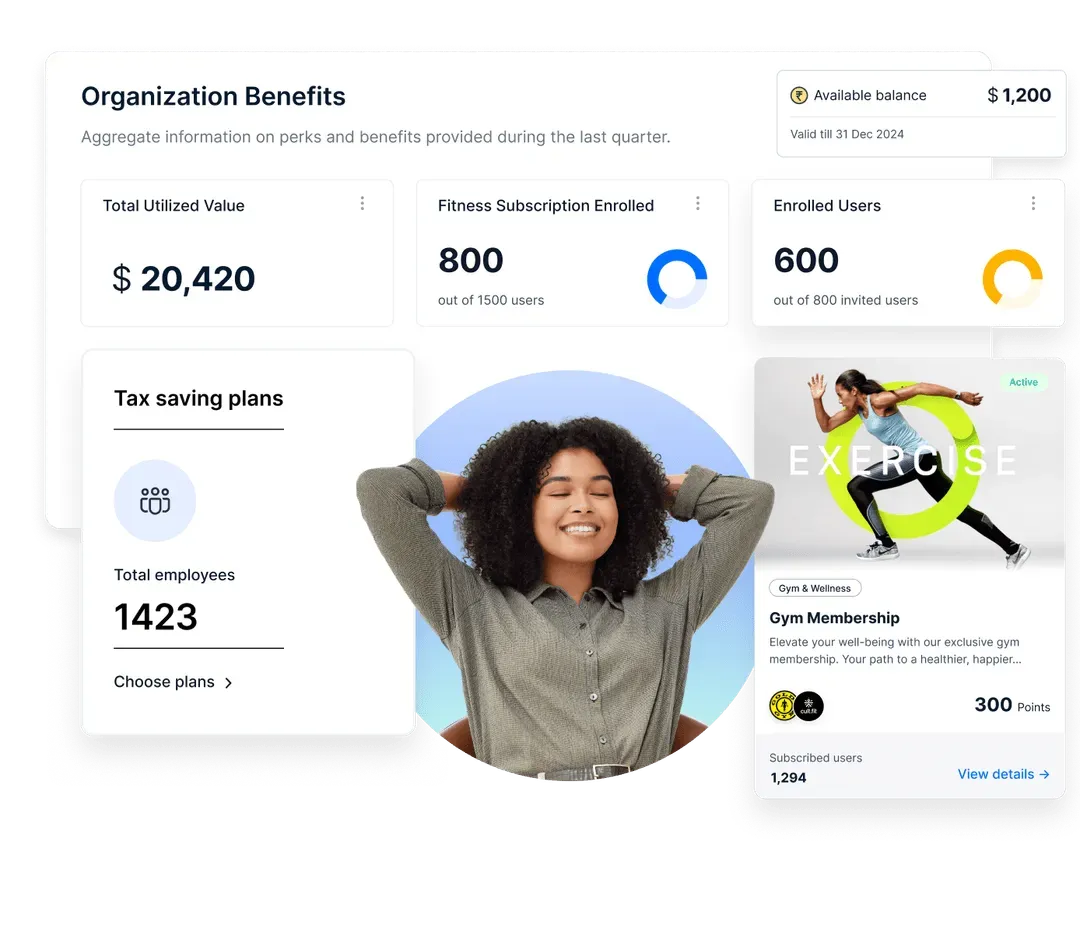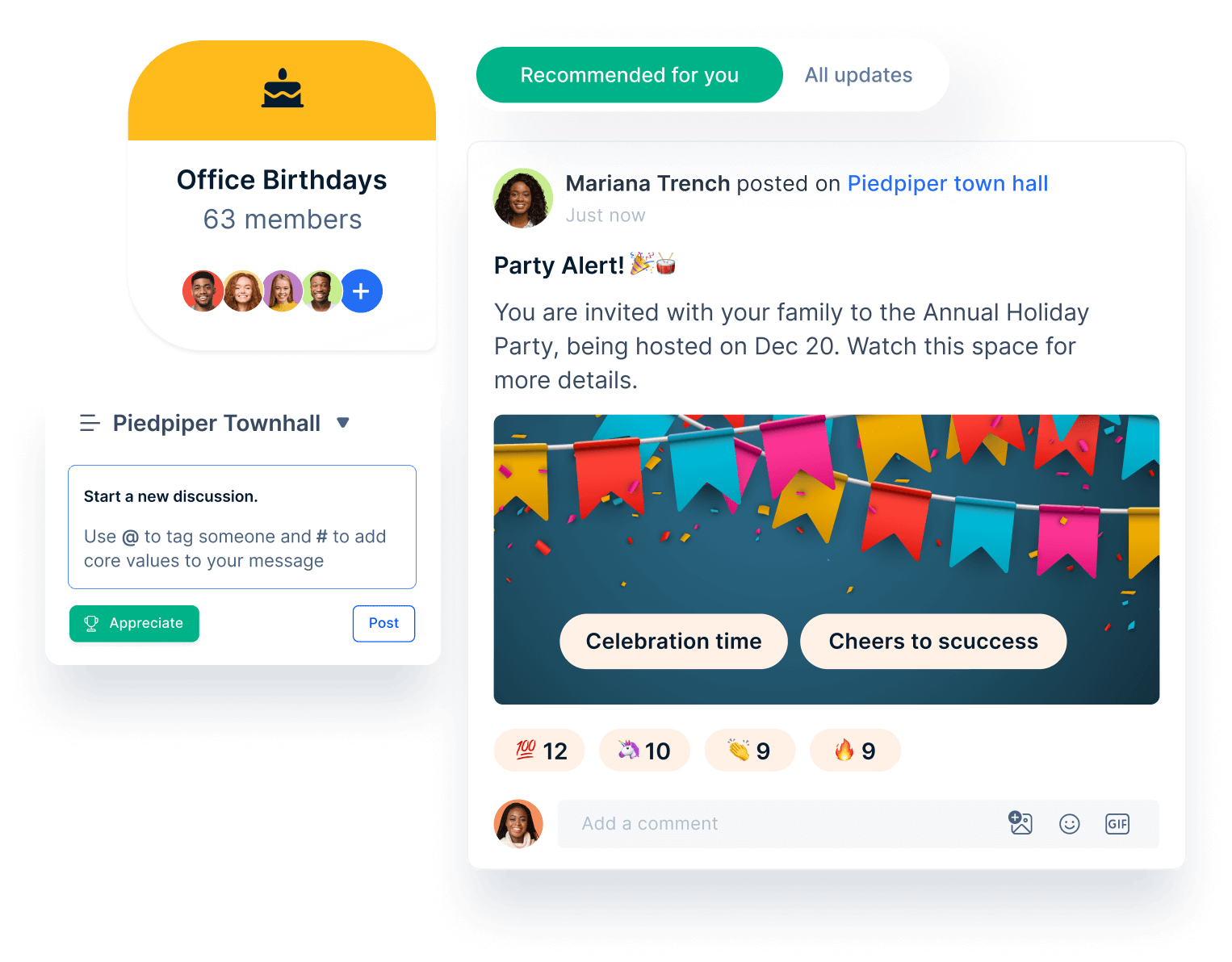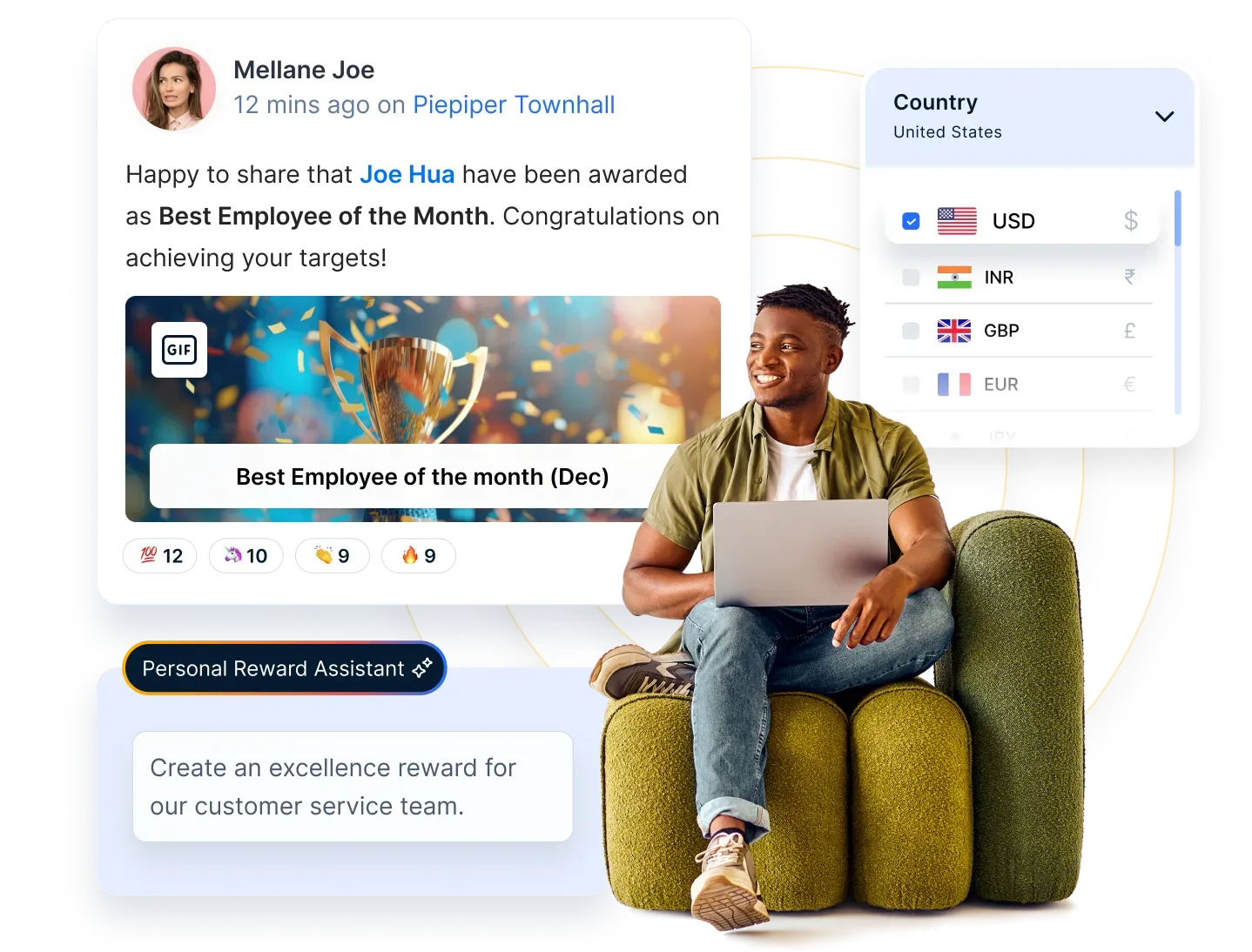Employee Assistance Program: Definition, Benefits, and Types
An employee assistance program helps reduce stress, improve productivity, and support well-being. Learn why your workplace needs one and how to set it up effectively.
On this page
- What is an employee assistance program?
- Why do you need an employee assistance program?
- Benefits of employee assistance program
- Types of employee assistance programs
- Employee assistance program cost
- How to set up employee assistance programs?
- How Empuls supports EAP goals
- ✅ Mental & emotional wellness support
- ✅ Culture of openness & belonging
- ✅ Recognition & motivation
- ✅ Continuous listening & feedback
- Employee assistance program laws
- Keys to success of the program
- List of employee assistance program providers
- Comprehensive employee wellness program framework
- Conclusion
Customers will never love a company until the employees love it first. -Simon Sinek
'Sam is absent today!'
'But why?'
'He's sick, sounded a bit stressed too.'
Stress isn't just costing employees but also employers. The study also revealed that stress led to violence, increased insurance costs, diminished productivity, and even accidents in some cases.
However, a simple assistance program can ease a lot for employees and employers.
What is an employee assistance program?
The employee's health insurance remains untouched, which means that the program doesn't cost employees anything. Employee assistance program providers hold a network of experienced professionals who helps in mental well-being, substance abuse, and more.
You can contract with an EAP provider in different ways, but that's for later. Let's understand why you need it in the first place.
Why do you need an employee assistance program?
Bensinger, DuPont & Associates surveyed 24000 employees and found that personal issues impact employees' work performance.
↠ Nearly 16 percent of the employees accepted that the personal issues caused absenteeism.
↠ Almost 50 percent of them reported a lack of focus due to the same problems.
However, employee replacement isn't the solution. An employer's annual earnings can reduce by 50% in doing so.
So, what should you do as an employer?
The solution is EAP.
Apart from improving productivity, EAPs can:
- ✅ Reduce absenteeism
- ✅ Lower labor disputes
- ✅ Reduce car accidents
- ✅ Lower insurance costs
- ✅ Heighten employee retention
- ✅ Improve employee engagement
Here's what else it covers.
The employee assistance programs have evolved in the past few years and now assist the employees more than substance abuse. EAP counseling is no longer limited to employees and has become available for their families.
Benefits of employee assistance program
Here are the benefits of employee assistance programs providers:
- Workplace conflicts: How to deal with cunning employees and managers.
- Alcohol or substance abuse: Dealing with a colleague's or family member's addiction to alcohol.
- Mental health issues: Assistance in depression, envy or anger management, low self-esteem, etc.
- Family or personal issues: Suggestions on dealing with domestic violence, separation, and even parenting issues.
- Health & caregiving issues: Managing disability/medical issues, and guidance in helping ill or elderly ones.
- Financial counseling: Credit card expense management or suggestions to avoid bankruptcy.
- Legal and family advice: Child custody, marriage counseling, or divorce issues.
- Grief assistance: The grief of losing a loved one or overcoming an accident at the workplace.
Types of employee assistance programs
Employers can contract with EAPs in many ways. Some common types of EAP programs are listed below.
1. Internal programs
- These programs allow employers to hire in-house counselors.
- Large companies with concentrated employees use internal programs, and on-site availability makes EAP counseling easy.
However, internal programs don't get appreciated among the employees as external do. The reason is that the employees are hesitant to use EAPs because of privacy.
2. External programs
- It's a regular contract-based program between the employer and the EAP provider.
- The program allows the employees to connect using a toll-free phone number.
- The EAP specialist will verify the details and suggest the best resources per the employee's geographical location.
3. Blended programs
- These programs are suitable for companies with large and small concentrated employees at different locations.
- The program allows the employees to use the services they like, either in-house or via a toll-free number.
Employee assistance program cost
The employers can customize the EAP's service as per their demands. And customization has a massive role in the involved cost. The small companies with more benefits tend to cost more.
Generally, an EAP program can cost you as low as $10 per employee, depending upon the company's services offered, location, and strength.
Here are the delivery models that vary your costs.
1. Fixed-fee contracts
The model includes per employee cost irrespective of how many employees use its services. The employee assistance program providers also offer assessments, counseling, and educational programs with this model.
2. Fee-for-service contracts
EAP providers and employer contracts directly, and the employer pays when an employee uses the services.
3. Consortia
Several small employers join together and contract with an EAP provider. The model helps in reducing the cost per employee.
How to set up employee assistance programs?
Setting up an employee assistance program aims to experience higher employee engagement, which will ultimately lead to more productivity in an agency. However, the results depend upon the factors you consider (listed below) while setting up an EAP.
1. Research the services your employee needs
Researching the needs will help you optimize costs without losing EAP's effectiveness. Many companies use internal assessments and surveys and collect the data to identify their employees' needs.
For example, you can identify the average age range of your workforce and choose the services they need from the collected data. Married employees will be more likely to use marriage counseling services, and new parents will prefer child care services.
2. Research the EAP provider
After identifying the required services, choose an employee assistance programs provider that'll help you meet perfection. Ask your competitors (with a similar workforce) and include their recommendations to create a list of employee assistance program providers.
Now, filter the options you've collected, and choose a qualified EAP based on the points listed below.
- ✅ Consider their years of service, the number of references, and their client base; the more, the better.
- ✅ Do they provide the services you need specifically?
- ✅ Do they provide services on-site, off-site, or both? And can they handle employees in different locations?
- ✅ Will the services be available 24/7?
- ✅ Does the EAP network have the respective credentials regarding health legal issues they provide?
- ✅ How many free sessions will be available before the employee has to pay?
- ✅ Consider EAP's response time when an employee contacts them.
- ✅ What do EAP's testimonials and reviews say about them?
Don't forget to check the EAP providers' list we have compiled for you in the end.
3. Promote the program among the employees
The employees might not start using EAP for two reasons confidentiality and unawareness. Julie Krause, Benefits Manager - U.S. Wellness at Microsoft, mentioned once that they launched a campaign (It's OK Not to Be OK) in May 2018.
The move opened the conversation about mental health and encouraged employees to use EAP resources.
Here's what you can do:
- ✅ Pin the pamphlets on bulletins and walls, where the employee can notice them frequently.
- ✅ Tell your employees that the service will be confidential and free. You can even call your EAP provider to explain the services via the workshop.
EAP's setup also involves a few legal issues, and the considerations can save you a lot.
How Empuls supports EAP goals
While Empuls doesn’t directly offer traditional EAP counseling, it acts as a powerful complement by holistically addressing the well-being, morale, and support structure that EAPs aim to foster:
✅ Mental & emotional wellness support

Empuls provides perks and benefits that alleviate stress:
- Fringe Benefits via Lifestyle Spending Accounts (LSAs) for health, wellness, learning, caregiving.
- Flexible Perks like fitness allowances, mental wellness resources, and remote work benefits.
- Early Access to Earned Wages, reducing financial anxiety.
✅ Culture of openness & belonging

Empuls’ Social Intranet boosts transparency and internal communication:
- Townhalls, community groups, wishboards, and digital celebrations nurture psychological safety.
- Employees feel more connected and aligned to the company’s mission, which directly counters isolation—a common stressor.
✅ Recognition & motivation

Empuls automates in-the-moment recognition and celebration of achievements, which:
- Boosts morale
- Reinforces positive behavior
- Encourages peer support and appreciation
This builds a resilient culture that supports mental well-being.
✅ Continuous listening & feedback

EAPs rely on understanding employee issues early—Empuls helps do this at scale:
- eNPS, pulse, and lifecycle surveys uncover areas of stress and disengagement.
- AI-powered analytics help HR take timely action.
Employee assistance program laws
Because employee assistance programs work closely with the employees, risks related legal issues are always involved.
In Hobson v. St. Luke's Hospital and Health Network, a paramedic sued his employer by alleging that his employment was terminated because his employer discriminated against his mental illness and his male gender.
Meanwhile, the plaintiff's termination occurred because he sexually harassed her female nurse co-worker. Thus, here's what you need to be cautioned about.
1. Confidentiality
Usually, EAP doesn't share an employee's confidential information without their consent. The exception occurs when an employer receives an end report about the services provided for the problems.
The employer must not publicize the information as the breach of confidentiality invites hefty compensation. The action can also cost an employee's reputation that may destroy his future.
2. Mandatory referral
An EAP referral must occur with the employee's consent, i.e., it needs to be voluntary. And when an employer mandates the referral because of the employee's illness, it's termed a mandatory referral.
In this case,
- The employer must record a decline in the employee's past performance to make his referral mandatory to an EAP provider.
- The employer must not threaten the employee's termination to impose the referral. The move invites a legal action that claims discrimination by an employer on an employee's mental illness.
Keys to success of the program
The success of the EAP program gets shared between employee and employer. Besides, the factors that support success are listed below.
1. Management regulated factors
The success speaks with these two factors that management handles.
- Program awareness is key to employee participation, and active participation is the first step to the program's success.
- Employees hesitate to participate because of confidentiality issues. You can address the issue in workshops conducted by EAP professionals.
2. KPI based factors
Active employee participation and higher ROI indicate more success. The program's ROI can be measured by the key performance indicators listed below.
- Improved productivity
- Reduced absenteeism
- Reduced accidents at Workplace
Here's what you need to do:
- Create a record of the employees that used the employee assistance program.
- Track employee engagement using reduced absenteeism, accidents at the workplace, employee productivity, etc., under a specific time.
- Note the difference and compile the results at the end. You can even appoint an in-house manager for it.
List of employee assistance program providers
Here, we have listed some EAP providers that have the highest reviews (listed more than ten) and a rating above 3.5:
- Go365
- Optum
- Gilsbar
- Virgin Pulse, Inc.
- Marquee Health
- Health Advocate
- Wellworks For You
- CuraLinc Healthcare
Comprehensive employee wellness program framework
Blend Empuls with an external EAP provider to offer proactive and reactive wellness support.
Step 1: Understand employee needs
Use Empuls surveys and analytics to uncover the real issues impacting your workforce.
Step 2: Choose an EAP provider
Select a certified provider that complements Empuls with confidential, expert-led support.
Step 3: Integrate Empuls with the EAP experience
Bridge data and action by mapping Empuls tools to EAP goals for seamless support.
Step 4: Communicate and destigmatize EAP access
Leverage Empuls intranet and campaigns to normalize seeking help and increase awareness.
Step 5: Promote holistic perks with Empuls
Offer meaningful financial, emotional, and lifestyle perks that reduce stress and build trust.
Step 6: Measure, iterate, and report
Track adoption, effectiveness, and ROI across both platforms to improve outcomes over time.
Recognize personal and professional milestones with Empuls to elevate morale and belonging. Schedule a call now to learn how Empuls can fit with your services seamlessly.
Conclusion
In the end, you cannot tell that your employees are stressed until their performance reflects. Encouraging your employees to discuss their issues is the most challenging task for an employer.
That's why choosing a suitable EAP matters. Select EAP testimonials and reviews as deciding factors because they'll help the firm's drivers.


















